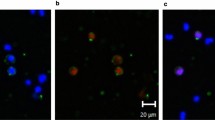Summary
Leukotriene B4 (LTB4) plays an important role in acute and chronic inflammatory and hypersensitive reactions. We studied the time course of LTB4 biosynthesis in whole blood in 18 patients with end-stage renal failure maintained on regular hemodialysis with two different membranes, cuprophane and polyacrylonitrile (AN 69). The basal levels of LTB4 from dialysis patients did not differ significantly from a normal control group. Compared to predialytic values, the cuprophane membrane caused a maximal release of LTB4 by a factor of about 4.5 (p<0.01) within the first 10 to 20 minutes. Thereafter the level fell and returned to baseline range at the end of the hemodialysis session. With the use of the AN 69 membrane no significant increase of LTB4 could be demonstrated. The changes in LTB4 concentration showed a close temporal correlation to the alterations in white blood cell count. We conclude that (1) LTB4 is a biologically important mediator of neutrophil activation during hemodialysis, and (2) LTB4 may be a sensitive marker of biocompatibility in vivo.
Similar content being viewed by others
Abbreviations
- LTB4 :
-
Leukotriene B4
- 5-HETE:
-
5-Hydroxyeicosatetraenoic acid
References
Basile C, Druecke T (1989) Dialysis membrane biocompatibility. Nephron 52:113–118
Betz M, Haensch GM, Rauterberg EW, Bommer J, Ritz E (1984) Cuprammonium membranes stimulate Interleukin 1 release and arachidonic acid metabolites in monocytes in the absence of complement. Kidney Int 34:67–73
Clancy RM, Dahinden CA, Hugli TE (1985) Complement-mediated arachidonate metabolism. Progr Biochem Pharmacol 20:120–131
Craddock P, Fehr E, Dalmasso A, Brigham K, Jacob H (1977) Hemodialysis leukopenia: pulmonary leukostasis resulting from complement activation by dialysis cuprophane membranes. J Clin Invest 59:879–888
De Broe ME, De Baker WA (1989) Pathophysiology of hemodialysis-associated hypoxemia. Adv Nephrol 18:297–316
Foidart JB, Davin JC, Malaise M, Saint-Remy M, Mahieu P (1985) Stimulation of platelet lipoxygenase during hemodialysis. Kidney Int 33 [Suppl 24]:80–81
Haag-Weber M, Hable M, Schollmeyer P, Hörl WH (1989) Metabolic response of neutrophils to uremia and dialysis. Kidney Int [Suppl 27]:293–298
Hakim RA (1985) Biocompatibility issues in hemodialysis. Proc Eur Dial Transplant 22:163–170
Hammerschmidt DE, Goldberg R, Raij L, Kay NE (1985) Leukocyte abnormalities in renal failure and hemodialysis. Sem Nephrol 5:91–103
Henderson LW, Chenoweth D (1987) Biocompatibility of artificial organs: an overview. Blood purification 5:100–111
Hoenich NA, Woffinden C, Ward MU (1989) Dialyzers. In: Maher JF (ed) Replacement of renal function by dialysis. Klüwer, Dodrecht, Holland, pp 144–180
Hörl WH, Jochum M, Heidland A, Fritz H (1983) Release of granulocyte proteinases during hemodialysis. Am J Nephrol 3:213–217
Jörres A, Richter D, Gahl M, Mahiout A (1990) Leukotriene B4 in patients on hemodialysis with cellulosic membranes. 27th Congress of the European Dialysis and Transplant Association, Vienna, p 163 (abstract)
Kolb G, Fischer M, Schoenemann H, Bathke K, Höffken H, Müller T, Lange H, Joseph K, Havemann K (1989) Effect of cuprophane, hemophane and polysulphone membranes on the oxidative metabolism, degranulation reaction, enzyme release and pulmonary sequestration of granulocytes. Contrib Nephrol 74:10–21
Lewis RA, Austen K, Soberman RJ (1990) Mechanisms of disease. Leukotrienes and other products of the 5-lipoxygenase pathway — biochemistry and relation to pathobiology in human disease. N Engl JM 323:645–655
Lewis SL, Van Epps DE (1987) Neutrophil and monocyte alterations in chronic dialysis patients. Am J Kidney Dis 9:381–395
Linke RP, Hampl H, Lobeck H, Ritz E, Bommer J, Waldherr R, Eulitz M (1989) Lysine-specific cleavage ofβ 2-microglobulin in amyloid deposits associated with hemodialysis. Kidney Int 36:675–681
Mahiout A, Jörres A, Hiss R, Meinhold H, Kessel M (1987) Effect of blood-dialyzer interaction on prostaglandins in uremic patients and in healthy man. Nephrol Dial Transplant 2:546–550
McMillan RM, Foster SJ (1988) Leukotriene B4 and inflammatory disease. Agents and Actions 24:114–119
Nacchache PH, Shaafi RI (1983) Arachidonic acid, leukotriene B4 and neutrophil activation. Ann NY Acad Sci 414:125–139
Newcombe DS (1988) Leukotrienes: regulation of biosynthesis, metabolism and bioactivity. J Clin Pharmacol 28:530–549
Remy PH, Hornych A, Luong N, Aumont J, Bariety J (1990) Biocompatibility of dialysis membranes: the role of leukotriences. 27th Congress of the European Dialysis and Transplant Association, Vienna, p 163 (abstract)
Strasser Th, Schiffl H (1990) Leukotriene B4 is involved in hemodialysis-associated neutropenia. Biochim Biophys Acta 1064:326–329
Author information
Authors and Affiliations
Rights and permissions
About this article
Cite this article
Strasser, T., Schiffl, H. Generation of leukotriene B4 by hemodialyzer membranes: A novel index of biocompatibility. Klin Wochenschr 69, 808–812 (1991). https://doi.org/10.1007/BF01744274
Received:
Revised:
Accepted:
Issue Date:
DOI: https://doi.org/10.1007/BF01744274




